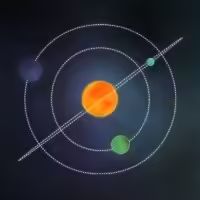You may be wondering how a target, one of thousands of targets in the Planet Hunters NGTS project, becomes a candidate and, hopefully, a real planet. In this series of posts, I want to explain a bit about the life cycle of a Planet Hunters NGTS target.
Once a group of subjects has “retired” from the site, once every subject has received responses from at least 20 users, the data is collected in a huge “csv” file (comma separated values). This file contains all responses from every volunteer for every subject included in the project, and is essentially a giant spreadsheet – but it is a file with millions of rows that would crash in a standard spreadsheet viewer like Excel. This huge file is then processed by a computer program to extract the most important data and enter it into a large database that is central to our activities.
From here, we can run another program to iteratively calculate the scores for each subject for each possible answer and calculate a weight for each user. This allows us to pay more attention to classifications that more easily identify transits and pick out high scoring subjects that may have been missed by a simple vote tally. This is similar to the scoring and weighting scheme used by Planet Hunters and the Planet Hunters TESS project, as well as many other citizen science projects. This allows us to generate a list of the most promising candidates (e.g., perhaps U-shaped subjects) that show up in the secondary eclipse and odd/even transit checks. We can then apply a similar program to these workflow classifications to identify subjects that are most likely to have no secondary eclipses or transit depth differences. These are the subjects that are most likely to be planetary transits rather than eclipsing binaries.
The next step is the most arduous: I look through all the candidates (there are usually a lot!) and choose the most promising ones to get a second opinion. With optimistic candidates in hand, I show them to the NGTS team, who evaluate them as a group and select the most promising planet candidates that we believe are worthy of further investigation. At this point, these objects are classified as potential planet candidates, but we can go through a series of tests using various data sources to determine whether they are planet candidates, which we will discuss in a future blog post.

